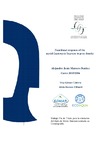Identificador persistente para citar o vincular este elemento:
https://accedacris.ulpgc.es/jspui/handle/10553/55882
| Campo DC | Valor | idioma |
|---|---|---|
| dc.contributor.advisor | Gómez Cabrera, María Milagrosa | - |
| dc.contributor.advisor | Herrera Ulibarri, Alicia | - |
| dc.contributor.author | Marrero Benítez, Alejandro Jesús | - |
| dc.date.accessioned | 2019-07-02T11:27:26Z | - |
| dc.date.available | 2019-07-02T11:27:26Z | - |
| dc.date.issued | 2016 | en_US |
| dc.identifier.uri | https://accedacris.ulpgc.es/handle/10553/55882 | - |
| dc.description.abstract | Mysids are key components in coastal ecosystems because they are a major link in the food-chain. The relationship between mysids and their prey is essential to appreciate the role in the food-chain and also to design laboratory experiments to better represent nature. For this reason, it was decided to determine Leptomysis lingvura´s predation rate with different concentration of Artemia nauplii. The mysids were placed in bottles for 24 hours. Then the water was filtered and the Artemia counted. In this way, Leptomysis lingvura´s predation rate was determined to vary between 1.39 and 36.57 Artemia∙mysid-1∙h-1, depending of food concentration. The predation rate functional response was type III with prey size, predator size and prey density being the principal factors influencing it | en_US |
| dc.language | eng | en_US |
| dc.subject | 2510 Oceanografía | en_US |
| dc.subject | 240119 Zoología marina | en_US |
| dc.subject | 240106 Ecología animal | en_US |
| dc.subject.other | Misidáceos | en_US |
| dc.subject.other | Ecología marina | en_US |
| dc.subject.other | Predator-prey | en_US |
| dc.title | Functional response of the mysid "Leptomysis lingvura" to prey density | en_US |
| dc.type | info:eu-repo/semantics/masterThesis | en_US |
| dc.type | MasterThesis | en_US |
| dc.contributor.departamento | Departamento de Biología | en_US |
| dc.contributor.facultad | Facultad de Ciencias del Mar | en_US |
| dc.investigacion | Ciencias | en_US |
| dc.type2 | Trabajo final de máster | en_US |
| dc.description.notas | Máster en Oceanografía ; 2015-2016 | en_US |
| dc.utils.revision | Sí | en_US |
| dc.identifier.matricula | TFT-37475 | es |
| dc.identifier.ulpgc | Sí | en_US |
| dc.contributor.buulpgc | BU-BAS | en_US |
| dc.contributor.titulacion | Máster Universitario en Oceanografía por la Universidad de Cádiz, la Universidad de Las Palmas de Gran Canaria y la Universidad de Vigo | es |
| item.grantfulltext | open | - |
| item.fulltext | Con texto completo | - |
| crisitem.advisor.dept | GIR ECOAQUA: Ecofisiología de Organismos Marinos | - |
| crisitem.advisor.dept | IU de Investigación en Acuicultura Sostenible y Ec | - |
| crisitem.advisor.dept | Departamento de Biología | - |
| crisitem.advisor.dept | GIR ECOAQUA: Ecofisiología de Organismos Marinos | - |
| crisitem.advisor.dept | IU de Investigación en Acuicultura Sostenible y Ec | - |
| crisitem.advisor.dept | Departamento de Biología | - |
| Colección: | Trabajo final de máster | |
Visitas
85
actualizado el 13-jul-2024
Descargas
78
actualizado el 13-jul-2024
Google ScholarTM
Verifica
Comparte
Exporta metadatos
Los elementos en ULPGC accedaCRIS están protegidos por derechos de autor con todos los derechos reservados, a menos que se indique lo contrario.
